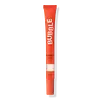What's inside
What's inside
 Key Ingredients
Key Ingredients

 Benefits
Benefits

 Concerns
Concerns

 Ingredients Side-by-side
Ingredients Side-by-side

Salicylic Acid 2%
MaskingWater
Skin ConditioningButylene Glycol
HumectantNigella Sativa Seed Extract
PerfumingIsopentyldiol
HumectantSodium Polyacrylate
AbsorbentLactic Acid
BufferingHydroxyethylcellulose
Emulsion StabilisingMelaleuca Alternifolia Leaf Oil
AntioxidantNiacinamide
SmoothingPolydextrose
HumectantCaffeine
Skin ConditioningMaltodextrin
AbsorbentXanthan Gum
EmulsifyingAllantoin
Skin ConditioningCeratonia Siliqua Gum
EmollientSodium Hydroxide
BufferingOpuntia Ficus-Indica Stem Extract
Skin ConditioningAgar
MaskingAloe Barbadensis Leaf Juice Powder
Skin ConditioningGlycerin
HumectantBiosaccharide Gum-1
HumectantMelia Azadirachta Leaf Extract
Skin ConditioningMelia Azadirachta Flower Extract
Skin Conditioning1,2-Hexanediol
Skin ConditioningCaprylyl Glycol
EmollientSodium Levulinate
Skin ConditioningGlyceryl Caprylate
EmollientTocopherol
AntioxidantTocopheryl Acetate
AntioxidantCoccinia Indica Fruit Extract
Skin ConditioningDisodium Phosphate
BufferingPolysorbate 60
EmulsifyingAmmonium Acryloyldimethyltaurate/Vp Copolymer
Gellan Gum
Sodium Anisate
AntimicrobialAloe Barbadensis Flower Extract
EmollientSolanum Melongena Fruit Extract
Skin ConditioningAzelaic Acid
BufferingCorallina Officinalis Extract
Skin ConditioningCurcuma Longa Root Extract
MaskingOcimum Sanctum Leaf Extract
Skin ConditioningSimmondsia Chinensis Seed Oil
EmollientSodium Phosphate
BufferingSebacic Acid
BufferingLimonene
PerfumingSalicylic Acid 2%, Water, Butylene Glycol, Nigella Sativa Seed Extract, Isopentyldiol, Sodium Polyacrylate, Lactic Acid, Hydroxyethylcellulose, Melaleuca Alternifolia Leaf Oil, Niacinamide, Polydextrose, Caffeine, Maltodextrin, Xanthan Gum, Allantoin, Ceratonia Siliqua Gum, Sodium Hydroxide, Opuntia Ficus-Indica Stem Extract, Agar, Aloe Barbadensis Leaf Juice Powder, Glycerin, Biosaccharide Gum-1, Melia Azadirachta Leaf Extract, Melia Azadirachta Flower Extract, 1,2-Hexanediol, Caprylyl Glycol, Sodium Levulinate, Glyceryl Caprylate, Tocopherol, Tocopheryl Acetate, Coccinia Indica Fruit Extract, Disodium Phosphate, Polysorbate 60, Ammonium Acryloyldimethyltaurate/Vp Copolymer, Gellan Gum, Sodium Anisate, Aloe Barbadensis Flower Extract, Solanum Melongena Fruit Extract, Azelaic Acid, Corallina Officinalis Extract, Curcuma Longa Root Extract, Ocimum Sanctum Leaf Extract, Simmondsia Chinensis Seed Oil, Sodium Phosphate, Sebacic Acid, Limonene
Salicylic Acid 1.8%
MaskingWater
Skin ConditioningPentylene Glycol
Skin ConditioningSodium Polyacrylate Crosspolymer-1
EmollientGaultheria Procumbens Leaf Extract
PerfumingGlycerin
HumectantAzelaic Acid
BufferingSalix Nigra Bark Extract
Skin ProtectingAloe Barbadensis Leaf Juice
Skin ConditioningZinc PCA
HumectantDipotassium Glycyrrhizate
HumectantSambucus Nigra Fruit Juice
AstringentSpiraea Ulmaria Flower Extract
Skin ConditioningCitric Acid
BufferingSodium Hydroxide
BufferingPhenoxyethanol
PreservativeSalicylic Acid 1.8%, Water, Pentylene Glycol, Sodium Polyacrylate Crosspolymer-1, Gaultheria Procumbens Leaf Extract, Glycerin, Azelaic Acid, Salix Nigra Bark Extract, Aloe Barbadensis Leaf Juice, Zinc PCA, Dipotassium Glycyrrhizate, Sambucus Nigra Fruit Juice, Spiraea Ulmaria Flower Extract, Citric Acid, Sodium Hydroxide, Phenoxyethanol
 Reviews
Reviews

Ingredients Explained
These ingredients are found in both products.
Ingredients higher up in an ingredient list are typically present in a larger amount.
Azelaic acid is a multitasker ingredient that helps treat acne, pigmentation, and irritation. It is a great option for sensitive skin.
What makes azelaic special?
The best thing about azelaic acid is it's gentleness. It's generally well-tolerated and safe to use alongside other actives like niacinamide or salicylic acid.
Unlike AHAs, azelaic acid will not make you photosensitive/sun sensitive.
You can find this ingredient naturally occurring in grains like wheat, rye, and barley. In cosmetics, azelaic acid is typically lab-made, which is more stable and effective.
Learn more about Azelaic AcidGlycerin is already naturally found in your skin. It helps moisturize and protect your skin.
A study from 2016 found glycerin to be more effective as a humectant than AHAs and hyaluronic acid.
As a humectant, it helps the skin stay hydrated by pulling moisture to your skin. The low molecular weight of glycerin allows it to pull moisture into the deeper layers of your skin.
Hydrated skin improves your skin barrier; Your skin barrier helps protect against irritants and bacteria.
Glycerin has also been found to have antimicrobial and antiviral properties. Due to these properties, glycerin is often used in wound and burn treatments.
In cosmetics, glycerin is usually derived from plants such as soybean or palm. However, it can also be sourced from animals, such as tallow or animal fat.
This ingredient is organic, colorless, odorless, and non-toxic.
Glycerin is the name for this ingredient in American English. British English uses Glycerol/Glycerine.
Learn more about GlycerinSalicylic Acid (also known as beta hydroxy acid or BHA) is a well-known ingredient for treating skin that struggles with acne and clogged pores. It exfoliates both the skin's surface and deep within the pores to help clear out buildup, control oil, and reduce inflammation.
Unlike AHAs (alpha hydroxy acids), salicylic acid is oil-soluble. This allows it to penetrate into pores which makes it especially effective for treating blackheads and preventing future breakouts.
Salicylic acid is also known for its soothing properties. It has a similar structure to aspirin and can calm inflamed or irritated skin, making it a good option for acne-prone skin that is also sensitive.
Concentrations of 0.5-2% are recognized by the U.S. FDA as an over-the-counter topical acne product.
It can cause irritation and/or dryness if one's skin already has a compromised moisture barrier, so it's best to focus on repairing that before introducing this ingredient into your routine.
While salicylic acid does not increase sun sensitivity, it’s still important to wear sunscreen daily to protect your skin.
If you are looking for the ingredient called BHA or Butylated Hydroxyanisole, click here.
Learn more about Salicylic AcidSodium Hydroxide is also known as lye or caustic soda. It is used to adjust the pH of products; many ingredients require a specific pH to be effective.
In small amounts, sodium hydroxide is considered safe to use. However, large amounts may cause chemical burns due to its high alkaline.
Your skin has a natural pH and acid mantle. This acid mantle helps prevent harmful bacteria from breaking through. The acid mantle also helps keep your skin hydrated.
"Alkaline" refers to a high pH level. A low pH level would be considered acidic.
Learn more about Sodium HydroxideWater. It's the most common cosmetic ingredient of all. You'll usually see it at the top of ingredient lists, meaning that it makes up the largest part of the product.
So why is it so popular? Water most often acts as a solvent - this means that it helps dissolve other ingredients into the formulation.
You'll also recognize water as that liquid we all need to stay alive. If you see this, drink a glass of water. Stay hydrated!
Learn more about Water